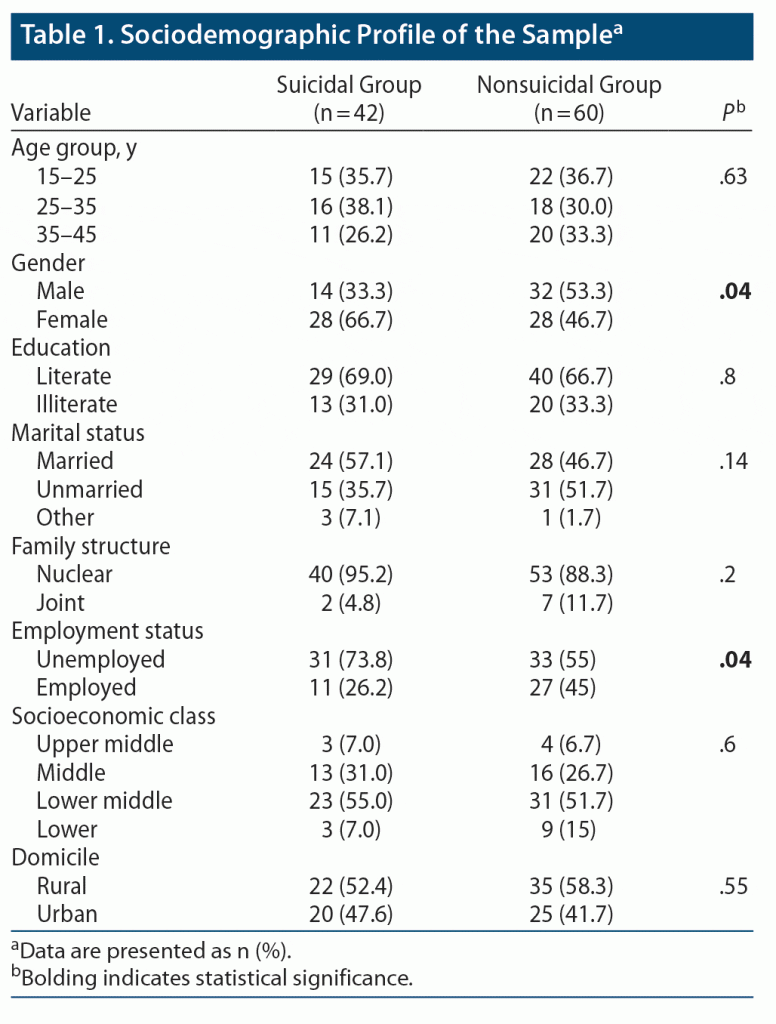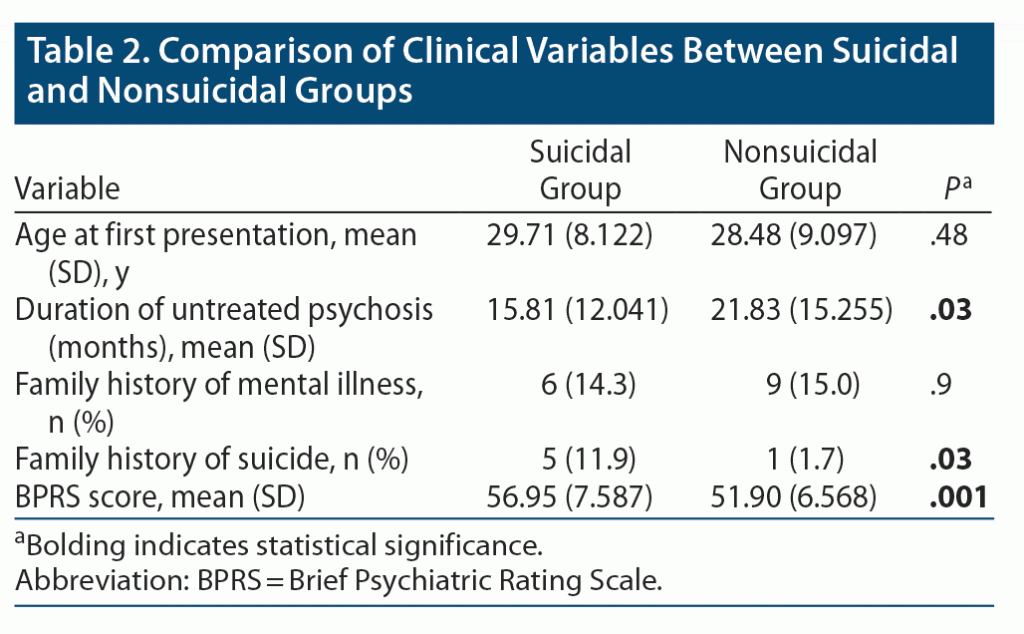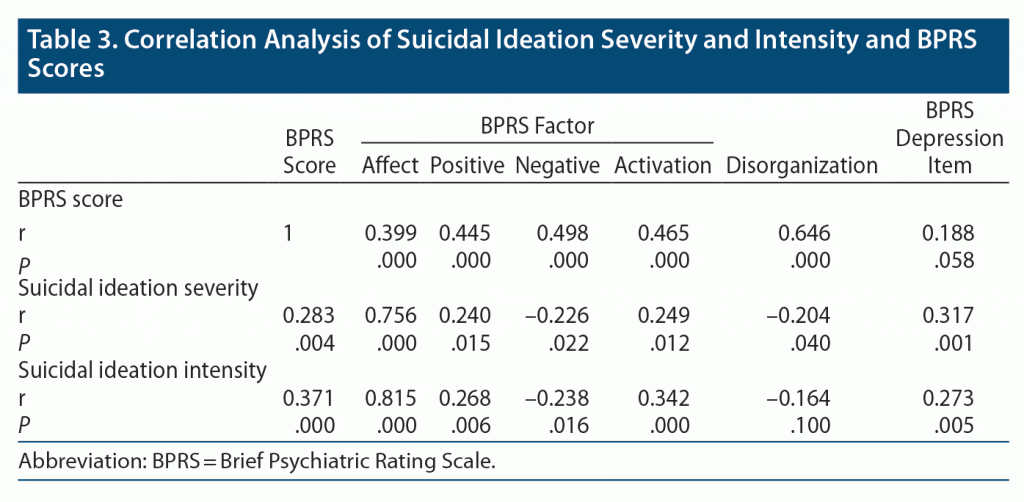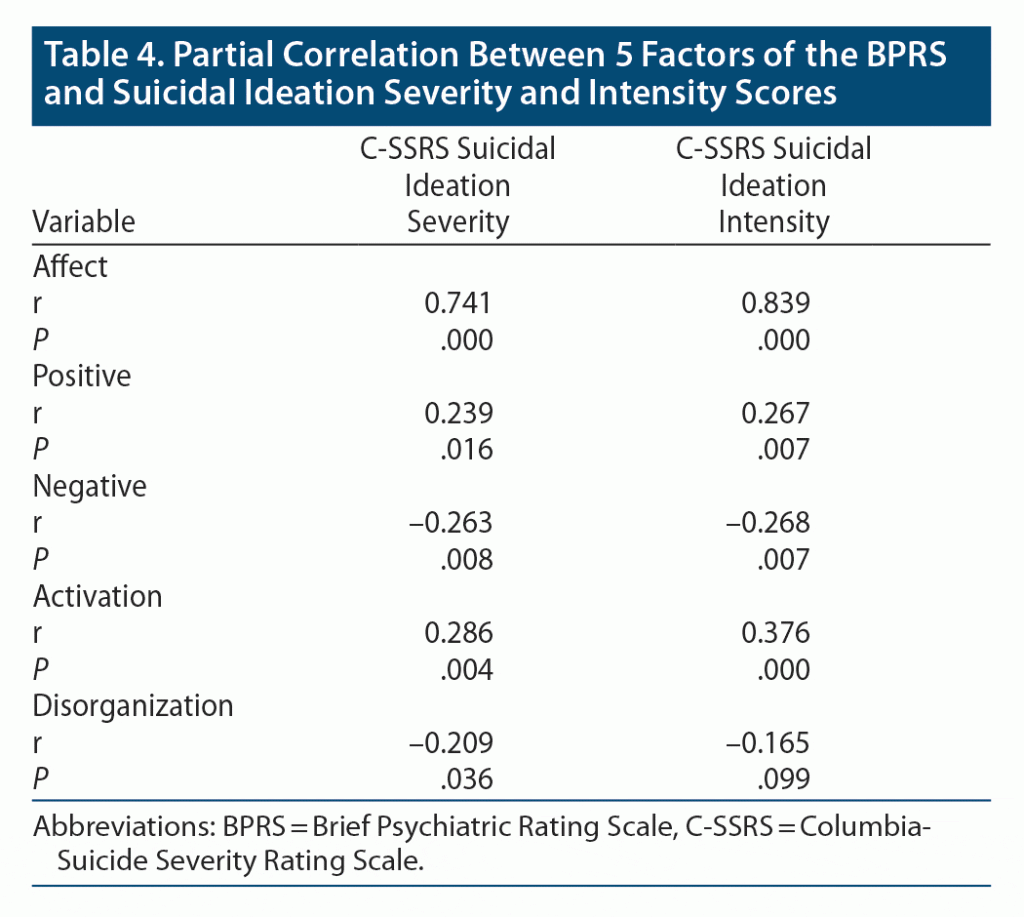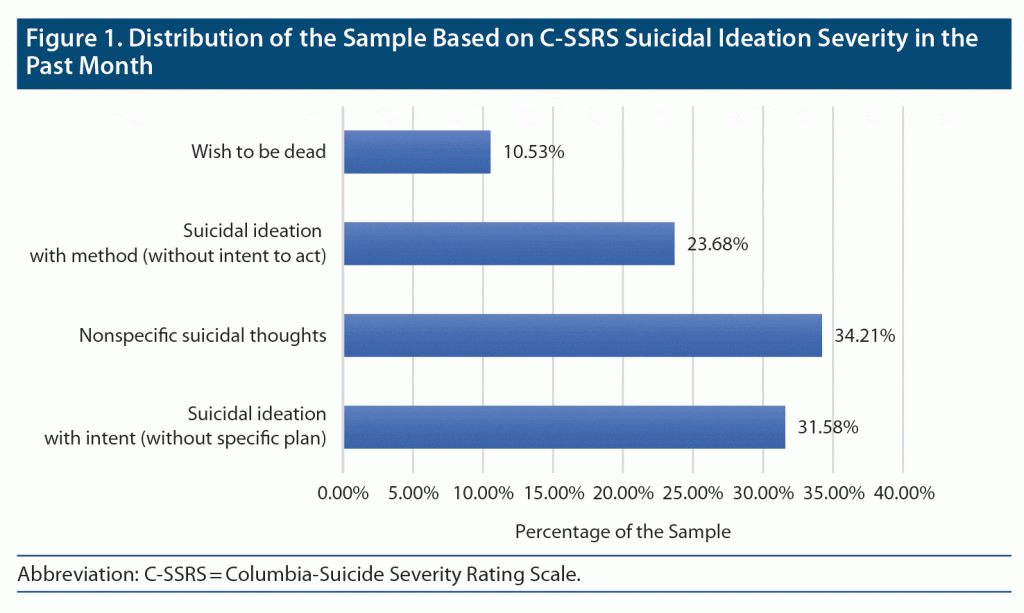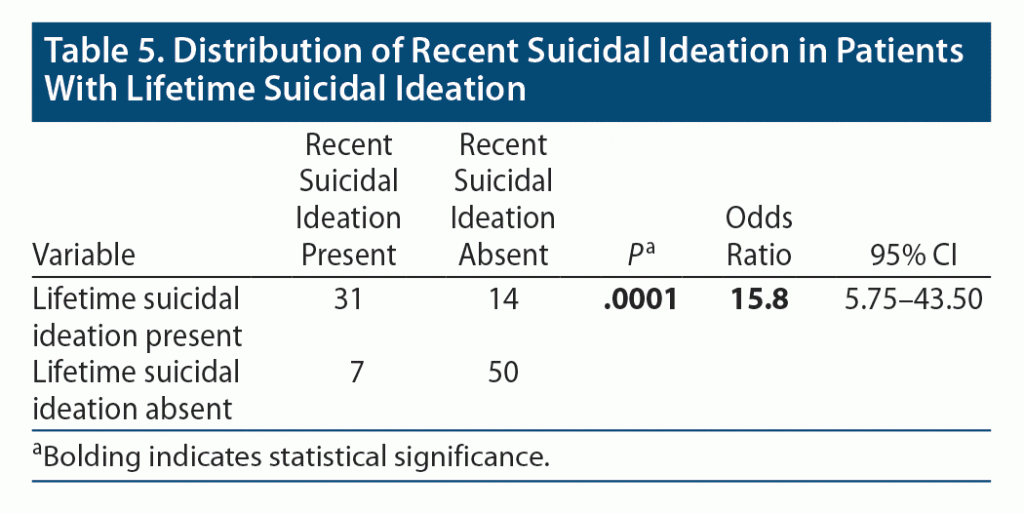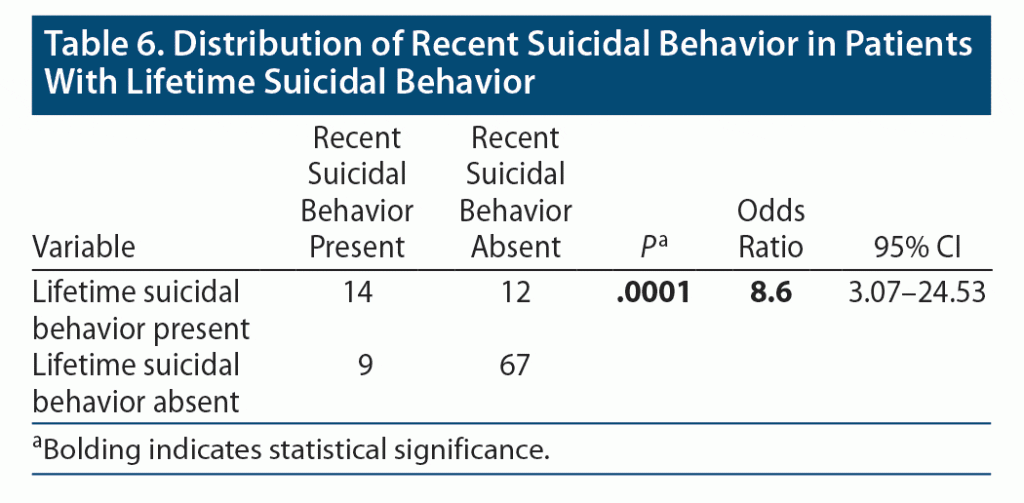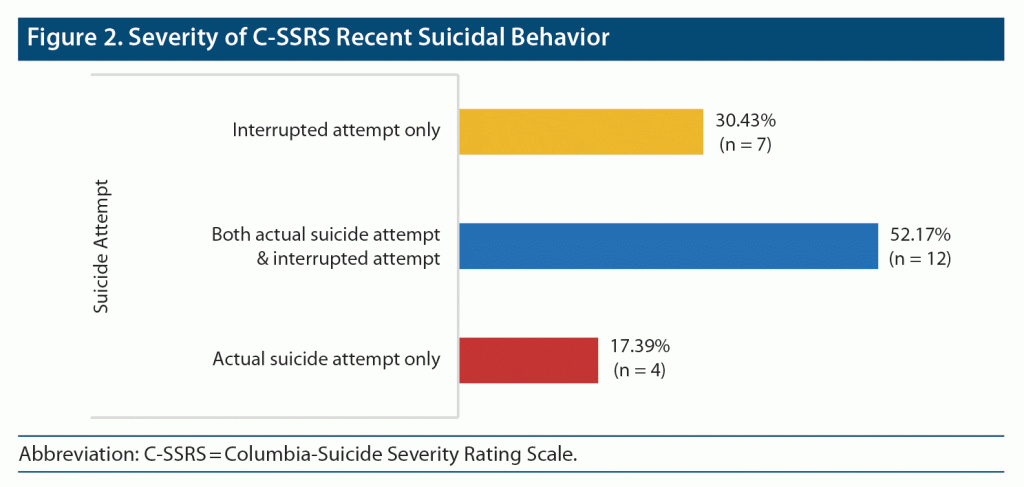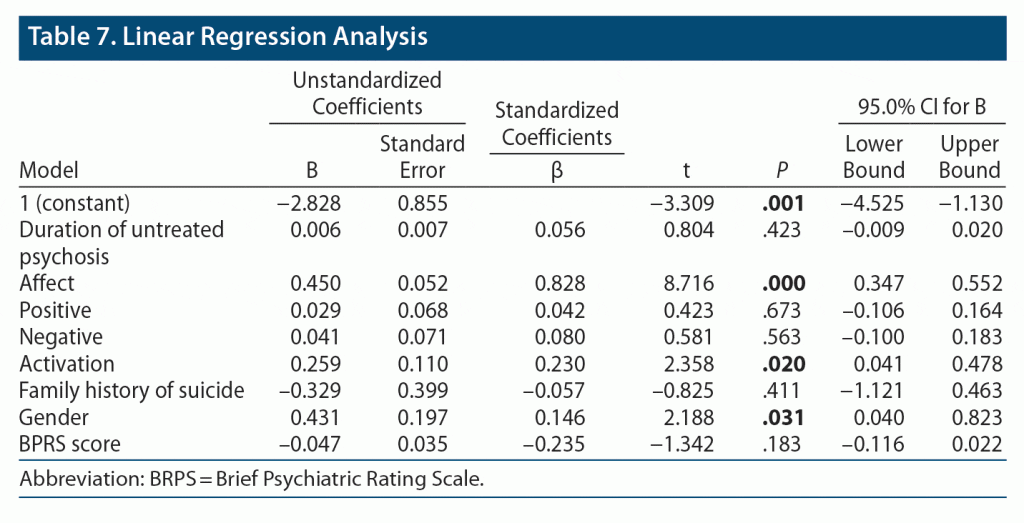ABSTRACT
Objective: The range of suicidal behavior in first-episode schizophrenia in the early phases of the disease is both understudied and unclear. The objective of this study was to investigate suicidal behavior in first-episode schizophrenia inpatients after admission.
Methods: The current study was conducted with 102 patients with first-episode schizophrenia aged 15 to 45 years who were admitted to a 300-bed psychiatry hospital in Southern India over a period of 18 months between January 1, 2016, and June 30, 2017. Patients completed a semistructured questionnaire, the Brief Psychiatric Rating Scale, and the Columbia-Suicide Severity Rating Scale for assessment of sociodemographic profile, psychopathology, and suicide risk. Patients were then divided into 2 groups: suicidal and nonsuicidal.
Results: Recent suicidal ideation and behavior were present in 37.25% and 22.54% of the first-episode schizophrenia patients, respectively. Recent suicidal ideation was 15.8 times more likely in first-episode schizophrenia patients with lifetime suicidal ideation, and recent suicide attempts were 8.6 times more likely in patients with lifetime suicide attempts.
Conclusions: The study results show that suicidal behavior in the early phases of first-episode schizophrenia is more prevalent during admission. Lifetime suicidal ideation and behavior predicts the risk of recent suicidal ideation and behavior, respectively.
Prim Care Companion CNS Disord 2023;25(3):22m03364
Author affiliations are listed at the end of this article.
Schizophrenia is one of the most puzzling yet disabling of all brain diseases, with its severe and persistent psychotic manifestations accompanied by variable cognitive dysfunction and profound psychosocial impairment. The symptoms of schizophrenia can be categorized into 5 dimensions: positive, negative, affective, cognitive, and aggressive. The aggressive and hostile symptom domains include overt hostility, such as verbal or physical abusiveness, and self-injurious behaviors, including suicide.1 Every year, over 800,000 people die from suicide, which roughly corresponds to 1 death every 40 seconds in the general population.2 Psychiatric disorders occupy a premier position in the pyramid of causation of suicide, and research shows that up to 90% of those who die by suicide have a psychiatric illness.2 Schizophrenia was associated with excess mortality, and 4 groups of factors were found to contribute to mortality.3 Suicide is first among them with 28% attribution, along with physical illnesses diagnosed late and treated insufficiently, antipsychotic medications, and unhealthy lifestyles.3 In a meta-analysis, Harris and Barraclough4 found that the risk of suicide among schizophrenia patients was more than 8 times higher than that of the general population. The lifetime risk of suicide in schizophrenia was found to be 10%, but studies have shown that the risk is likely to be between 4% and 6% and approximately 20%–40% for suicide attempts.5–7 For patients with schizophrenia, there were 2 sharp peaks in suicide risk. The first is immediately after admission, and the second is shortly after discharge. Suicide risk occurs in different phases of the first episode of schizophrenia, including the prodromal, acute psychosis, and post-psychotic phases.8 The estimate of lifetime suicide prevalence in first admission or illness onset was 5.6%.6
Earlier studies on suicide in schizophrenia and first-episode schizophrenia had methodological limitations including retrospective evaluations, use of case and death registers, and imprecise definition of first-episode schizophrenia. Suicidal behavior in schizophrenia contributes significantly to premature mortality. Hence, assessment of suicidal behavior ranging from suicide ideation to attempt in the early course of illness, particularly at first contact with the hospital, needs to be included as part of the mental health assessment so that provision of early interventions can be made. Much of the research has been focused on the lifetime risk of completed suicide, which represents the tip of the iceberg and neglects the submerged portion of nonfatal suicidal behavior that is far more common. The range of suicidal behavior in first-episode schizophrenia in the early phases of the disease is both understudied and unclear. Therefore, the objective of this study was to investigate suicidal behavior in first-episode schizophrenia using a structured questionnaire immediately after admission.
METHODS
Participants
This was a cross-sectional study conducted in a tertiary care psychiatric hospital, and the institution’s ethics committee provided approval before the study began (REG.NO.2/IEC/AMC/2017). A sample of 102 first-episode schizophrenia patients admitted between January 1, 2016, and June 30, 2017, for a period of 18 months were recruited by purposive sampling. The inclusion criteria were inpatients with a diagnosis of schizophrenia according to ICD-10 research diagnostic criteria. The patients were between age 15 and 45 years and were male and female. First episode is defined as first psychiatric hospitalization,9 drug naive or < 12 weeks cumulative (lifetime) antipsychotic treatment,10–14 and duration of untreated psychosis < 5 years.12 The exclusion criteria were patients with other comorbid psychiatric illness or severe medical illness at present admission and cases in which self-harm was found to be accidental. After detailed explanation regarding the nature and purpose of the study, an information sheet was provided, and written informed consent was taken for participation in the study.
Research Tools
Semistructured questionnaire. The semistructured questionnaire consisted of the sociodemographic variables such as age, gender, domicile, marital status, socioeconomic class, employment, literacy, and clinical variables like age at first presentation, duration of untreated psychosis (DUP), and family history of mental illness.
Brief Psychiatric Rating Scale. The Brief Psychiatric Rating Scale (BPRS) 24-symptom construct was used for assessment of psychopathology. The BPRS has excellent interrater reliability, and studies have reported a range of median Pearson correlation coefficients and intraclass correlation coefficients from 0.67 to 0.88.15 Five factors of the BPRS were adopted from a meta-analysis of BPRS factor structure analysis (ie, affect, positive symptoms, negative symptoms, activation, and disorganization factor).16
Columbia-Suicide Severity Rating Scale Lifetime/Recent Version. The Columbia-Suicide Severity Rating Scale (C-SSRS) Telugu translation was used for assessment of suicidal ideation (SI) and behavior. One of the authors (S.M.G.) has been trained and certified for application of the C-SSRS. The C-SSRS has domains of SI and behavior that evaluate 4 constructs (ie, severity, intensity of SI, suicide behavior, and lethality of attempts). The C-SSRS severity (r = 0.69, P < .001) and intensity (r = 0.34, P < .001) subscales have good correlation with the Scale for Suicide Ideation.17
Statistical Analysis
Data analysis was performed using SPSS software (version 23) and Microsoft Excel 2016. Descriptive analysis was used for frequency and distribution of variables. Independent t and χ2 tests were used to find association between variables. Odds ratio was used to determine the strength of association only for variables that showed significant association on the independent t and χ2 tests. Correlational analysis was used for continuous variables. P value < .05 was considered statistically significant at 95% CIs. A linear regression analysis was done to assess the predictors of SI.
RESULTS
Sociodemographic Data of the Suicidal and Nonsuicidal Groups
The 102 first-episode schizophrenia patients were divided into 2 groups: suicidal and nonsuicidal. The patients with a BPRS item 4 (suicidality) score < 2 were grouped as nonsuicidal, and those with a score > 2 were grouped as suicidal. The mean age of the first-episode sample with suicidality was 30.9 years. In first-episode schizophrenia patients with suicidality, the majority were in the age groups of 25–35 years and 15–25 years. Most were female (67%), literate (69%), married (57%), living in a nuclear family (95%), unemployed (74%), residing in rural areas (52%), and belonged to the lower middle and middle class (86%). The difference between the 2 groups was statistically significant only for gender and employment. The odds ratio (OR) for (female) gender was 2.28 with 95% CI, 1–5.07, and the OR for employment (unemployed) status was 2.3 with 95% CI, 1.06–5.01. No association was found with other sociodemographic data, as shown in Table 1.
Comparison of Clinical Variables Between the Suicidal and Nonsuicidal Groups
The mean age at first presentation of symptoms was 29.7 years in the suicidal group. The majority (61.9%) had < 1 year of untreated psychosis, and the mean DUP was significantly shorter (15.81 months) in the suicidal group than in the nonsuicidal group (21.3 months). Family history of suicide was present in 11.9% of the suicidal group with significant association with suicidal behavior (OR = 7.9, 95% CI, 0.98–5.42). The mean BPRS score of suicidal patients was significantly higher than that of nonsuicidal patients, as shown in Table 2. There was a significant difference in the following items: anxiety, depression, self-neglect, motor retardation, tension, emotional withdrawal, and motor hyperactivity of the BPRS. Positive, affective, and activation symptoms were significantly higher and negative symptoms were significantly lower in the suicidal group compared to the nonsuicidal group, as seen in Supplementary Table 1.
Correlation Analysis of Suicidal Ideation Severity and Intensity Scores and BPRS Scores
There was a positive correlation between BPRS scores and SI severity and intensity scores that was statistically significant at P < .05. SI severity had a positive correlation with affective, positive, and activation factors of the BPRS, whereas its correlation with negative and disorganization factors was negative, as shown in Table 3. The depression item score of the BPRS was also correlated with severity of recent SI (r = 0.317, P = .001) and intensity of SI (r = 0.273, P = .005). In the partial correlation analysis after adjusting for the depression item score of the BPRS, negative symptoms remained significantly negatively correlated with both the severity (r = −0.263, P = .008) and intensity (r = −0.268, P = .007) of recent SI. The positive, activation, and affect symptoms correlation also remained significant, as shown in Table 4.
Suicidal Ideation
Figure 1 shows distribution of recent SI severity in the past month, with recent SI present in 37.25% (n = 38). SI with method but no intent was reported by 23.7%, and SI with intent but no specific plan was reported by 31.6%, whereas nonspecific suicidal thoughts were reported by 34.2%. Lifetime SI was present in 44.1% of the first-episode schizophrenia patients. The OR was 15.8 (P = .0001), with recent SI 15.8 times more likely in patients with lifetime SI, as shown in Table 5.
Suicidal and Nonsuicidal Self-Injurious Behavior
Table 6 shows the distribution of current and lifetime suicidal behavior. Suicide attempts were present in 22.5% (n = 23) and nonsuicidal self-injurious behavior without intent in 3.9% (n = 4) in the past 3 months, whereas lifetime suicidal behavior was present in 25.5%. More than half of the first-episode schizophrenia patients with recent suicide attempts had more than 1 attempt (52.2%), and actual attempts only were found in 16 of 23 patients with recent attempts. Of the 26 patients with lifetime suicidal behavior, recent suicidal behavior was present in 53.8% compared to 11.8% who had recent suicidal behavior without lifetime suicidal behavior (OR = 8.6, P = .0001).
The severity of recent suicidal behavior/attempts is shown in Figure 2, with actual attempts in 16 patients and interrupted attempts in 19 first-episode schizophrenia admissions over the past 3 months. There was no physical damage in 13 patients, 2 patients had minor physical damage, and only 1 patient had moderate physical damage that required medical attention. Among the 13 patients with actual suicide attempts with no physical damage, 7 patients had behavior likely to result in death, and the remaining 6 patients had behavior likely to result in injury but not death.
Prediction Model of Suicidal Ideation: Linear Regression Analysis
Table 7 shows a linear regression model for predicting SI with C-SSRS SI severity score being the dependent variable and the variables that have a significant association and correlation as independent variables. The linear regression analysis results revealed that the overall model was significant (F = 18.94, P = .000), and 62% variance in severity of SI was explained by independent variables collectively with adjusted R2 = 0.62. Among the clinical and sociodemographic variables, gender was the significant predictor of recent SI severity, while DUP and family history of suicide did not predict severity of recent SI. The affect and activation factors of the BPRS were the significantly positive predictors of severity of recent SI.
DISCUSSION
The current Indian study found similar patterns of suicide risk as that of studies conducted in other nations/cultures among first-episode schizophrenia patients, indicating the cross-cultural generalizability of suicide risk, although motives behind the suicide risk may be culturally discrete. Suicidality was frequently observed in first-episode schizophrenia patients with female gender, unemployment status, genetic loading, severity of psychopathology, and probable use of lethal means. The activation and affect domains of psychopathology significantly predicted the severity of SI, while negative symptoms had a protective role against suicidal risk. Among the sociodemographic variables, female gender was more likely to be associated with suicidal behavior in the current study, which is consistent with earlier research.10,18,19 However, this finding is contrary to a study20 wherein 70% of suicide attempters were male and a few first-episode studies in which no gender difference was observed.21,22 The contrary findings of this study can be explained with the assumption that as in the general population, suicide attempts might be more common in females with schizophrenia.23,24 Unemployment was also associated with suicidality, which is consistent with earlier research and corresponds with Durkheim’s theory that suicides occur during periods of economic crisis.25–28
The present study finding of shorter DUP significantly associated with suicidality is consistent with that of Preti et al29 but contrary to studies in which long DUP was associated with suicidal behavior22,30 and others in which no association was found.11,21 The association of suicidality with short DUP may be due to the active psychosis, acting out, and lack of insight; another assumption is that suicidal behavior prompts early presentation to the hospital, which shortens DUP. There was a significant association of family history of suicide with suicidal behavior in this study, which is consistent with previous research, and the study by De Hert et al31 reported that the odds of suicidal behavior was 8 times higher when family history of suicide was present.25,32
Significantly higher BPRS scores in suicidal patients and the positive correlation of positive and affect factors with SI severity and intensity in the current study are comparable to earlier literature.33–35 The negative correlation of negative symptoms with SI severity and intensity is consistent with previous studies.33,36 This explains the protective role of negative symptoms like motor retardation and emotional withdrawal in patients with SI that hampers motor activity. The symptoms of anhedonia and avolition decrease the motivated self-initiated purposeful activities by inhibiting the volition and motivation of the individual and reduce risk of suicide.37 In this study, lifetime SI was present in 44.1% of patients, which is higher than in the study by Melle et al38 but similar to other studies.21,39 Lifetime suicide attempts were present in 25.49% of patients in the current study, which is comparable to a study by Bakst et al,21 who found lifetime suicide attempts of 28%, but higher than other studies.38,39
In this study, 37.25% of patients were found to have recent SI, which is comparable to earlier studies21,39,40 but higher than others.35,38 In this study, the most prevalent level of SI was active nonspecific suicidal thoughts followed by SI with some intent, which is contrary to the findings of Gill et al40 wherein less severe passive ideation was most prevalent. Passive ideation was present in 10.53%, which is similar to the study by Kontaxakis et al,41 which reported passive ideation in 11.8% of patients with acute schizophrenia, but lower than a study by Tarrier et al,30 wherein 20.3% reported a “weak desire” to kill themselves. The active suicidal thoughts with or without some intent that were frequently harbored in first-episode schizophrenia admissions in the current study might be due to the nature of psychopathology, particularly the positive, activation, and affective symptoms observed in the acute psychosis state.
The prevalence of recent suicidal behavior in this study (22.54%) was much higher than that reported by Melle et al38 but consistent with a study by Sanchez-Gistau et al,42 in which past suicide attempts predicted baseline suicide risk. Among patients with suicidal behavior, both actual and interrupted attempt were present in 52.17%, while only actual attempt was present in 17.39% with probable high lethality. These findings are consistent with earlier studies that found schizophrenia patients use more violent and lethal methods of attempting suicide.43–45 There are not many studies, to the best of our knowledge, investigating this parameter in schizophrenia.
CONCLUSION
There is a dearth of studies in the Asian and Indian context pertaining to first-episode schizophrenia. Thus, the current study provides insights for a range of suicidal behavior in first-episode schizophrenia inpatients, focusing on the neglected nonfatal suicidal behavior that is far more common. Suicidal behavior in first-episode schizophrenia in the early phases of illness is more prevalent, and lifetime SI and behavior predicts the risk of suicide. Thus, a holistic approach is needed with first-episode schizophrenia patients, using standard questionnaires for assessment of suicide. However, the scope of this study was limited by the cross-sectional nature of the study design and lack of inclusion of first-episode schizophrenia patients who were receiving outpatient treatment. This study also did not include the clinical variable “insight,” which was assessed in many studies associated with suicidal behavior in schizophrenia patients. Although the findings should be interpreted with caution, this study has strengths of an adequate well-defined sample and the use of validated instruments. A prospective cohort study examining suicidal behavior during different phases of first-episode schizophrenia, from prodrome to acute to recovery to post-recovery, would be more informative in future research.
Article Information
Published online: June 20, 2023. https://doi.org/10.4088/PCC.22m03364
© 2023 Physicians Postgraduate Press, Inc.
Submitted: July 9, 2022; accepted November 18, 2022.
To Cite: Godi SM, Nagaraju S, Padma V. Study of suicidal behavior among admitted first-episode schizophrenia patients from South India. Prim Care Companion CNS Disord. 2023;25(3):22m03364.
Author Affiliations: Department of Psychiatry, Andhra Medical College, Visakhapatnam, India (Godi, Nagaraju, Padma).
Corresponding Author: Sangha Mitra Godi, MD, Department of Psychiatry, Central Institute of Psychiatry, Ranchi, Jharkhand, India 834006 ([email protected]).
Relevant Financial Relationships: None.
Funding/Support: None.
Supplementary Material: See accompanying pages.
Clinical Points
- Suicidal behavior is most prevalent in the early phases of illness in first-episode schizophrenia, particularly during admission, and lifetime suicidal behavior predicts the risk of recent suicidal behavior.
- Female gender and affective and activation factors of the Brief Psychiatric Rating Scale were significant predictors of severity of recent suicidal ideation.
- The evaluation of suicidal behavior over the course of hospitalization should be done as part of the mental health assessment in first-episode schizophrenia patients so that provision of early interventions can be made.
References (45)

- Stahl SM. Stahl’s Essential Psychopharmacology: Neuroscientific Basis and Practical Application. 4th ed. Cambridge University Press; 2013.
- World Health Organization. Preventing suicide: A global imperative. Accessed May 20, 2021. https://www.who.int/publications/i/item/9789241564779
- Laursen TM, Nordentoft M, Mortensen PB. Excess early mortality in schizophrenia. Annu Rev Clin Psychol. 2014;10(1):425–448. PubMed CrossRef
- Harris EC, Barraclough B. Suicide as an outcome for mental disorders: a meta-analysis. Br J Psychiatry. 1997;170(3):205–228. PubMed CrossRef
- Miles CP. Conditions predisposing to suicide: a review. J Nerv Ment Dis. 1977;164(4):231–246. PubMed CrossRef
- Palmer BA, Pankratz VS, Bostwick JM. The lifetime risk of suicide in schizophrenia: a reexamination. Arch Gen Psychiatry. 2005;62(3):247–253. PubMed CrossRef
- Inskip HM, Harris EC, Barraclough B. Lifetime risk of suicide for affective disorder, alcoholism and schizophrenia. Br J Psychiatry. 1998;172(1):35–37. PubMed CrossRef
- Ventriglio A, Gentile A, Bonfitto I, et al. Suicide in the early stage of schizophrenia. Front Psychiatry. 2016;7:116. PubMed CrossRef
- Takayanagi Y, Takahashi T, Orikabe L, et al. Classification of first-episode schizophrenia patients and healthy subjects by automated MRI measures of regional brain volume and cortical thickness. PLoS One. 2011;6(6):e21047. PubMed CrossRef
- Bertelsen M, Jeppesen P, Petersen L, et al. Suicidal behavior and mortality in first-episode psychosis: the OPUS trial. Br J Psychiatry suppl. 2007;51(S51):s140–s146. PubMed CrossRef
- Nordentoft M, Jeppesen P, Abel M, et al. OPUS study: suicidal behavior, suicidal ideation and hopelessness among patients with first-episode psychosis: one-year follow-up of a randomized controlled trial. Br J Psychiatry suppl. 2002;181(S43):S98–S106. PubMed CrossRef
- Breitborde NJK, Srihari VH, Woods SW. Review of the operational definition for first-episode psychosis. Early Interv Psychiatry. 2009;3(4):259–265. PubMed CrossRef
- Szeszko PR, Strous RD, Goldman RS, et al. Neuropsychological correlates of hippocampal volumes in patients experiencing a first episode of schizophrenia. Am J Psychiatry. 2002;159(2):217–226. PubMed CrossRef
- Joyce E, Hutton S, Mutsatsa S, et al. Executive dysfunction in first-episode schizophrenia and relationship to duration of untreated psychosis: the West London Study. Br J Psychiatry suppl. 2002;181(S43):S38–S44. PubMed CrossRef
- Overall JE, Gorham DR. The Brief Psychiatric Rating Scale (BPRS): recent developments in ascertainment and scaling. Psychopharmacol Bull. 1988;24(1):97–99.
- Dazzi F, Shafer A, Lauriola M. Meta-analysis of the Brief Psychiatric Rating Scale-Expanded (BPRS-E) structure and arguments for a new version. J Psychiatr Res. 2016;81:140–151. PubMed CrossRef
- Posner K, Brown GK, Stanley B, et al. The Columbia-Suicide Severity Rating Scale: initial validity and internal consistency findings from three multisite studies with adolescents and adults. Am J Psychiatry. 2011;168(12):1266–1277. PubMed CrossRef
- Austad G, Joa I, Johannessen JO, et al. Gender differences in suicidal behavior in patients with first-episode psychosis. Early Interv Psychiatry. 2015;9(4):300–307. PubMed CrossRef
- Fuller-Thomson E, Hollister B. Schizophrenia and suicide attempts: findings from a representative community-based Canadian sample. Schizophr Res Treatment. 2016;2016:3165243. PubMed CrossRef
- Ayesa-Arriola R, Alcaraz EG, Hernández BV, et al. Suicidal behavior in first-episode non-affective psychosis: specific risk periods and stage-related factors. Eur Neuropsychopharmacol. 2015;25(12):2278–2288. PubMed CrossRef
- Bakst S, Rabinowitz J, Bromet EJ. Antecedents and patterns of suicide behavior in first-admission psychosis. Schizophr Bull. 2010;36(4):880–889. PubMed CrossRef
- Clarke M, Whitty P, Browne S, et al. Suicidality in first episode psychosis. Schizophr Res. 2006;86(1-3):221–225. PubMed CrossRef
- Dutta R, Murray RM, Hotopf M, et al. Reassessing the long-term risk of suicide after a first episode of psychosis. Arch Gen Psychiatry. 2010;67(12):1230–1237. PubMed CrossRef
- Lester D. Sex differences in completed suicide by schizophrenic patients: a meta-analysis. Suicide Life Threat Behav. 2006;36(1):50–56. PubMed CrossRef
- Ayalew M, Defar S, Reta Y. Suicide behavior and its predictors in patients with schizophrenia in Ethiopia. Schizophr Res Treatment. 2021:6662765. PubMed CrossRef
- Hawton K, Sutton L, Haw C, et al. Schizophrenia and suicide: systematic review of risk factors. Br J Psychiatry. 2005;187(1):9–20. PubMed CrossRef
- Pompili M, Mancinelli I, Ruberto A, et al. Where schizophrenic patients commit suicide: a review of suicide among inpatients and former inpatients. Int J Psychiatry Med. 2005;35(2):171–190. PubMed CrossRef
- Mueller AS, Abrutyn S, Pescosolido B, et al. The social roots of suicide: theorizing how the external social world matters to suicide and suicide prevention. Front Psychol. 2021;12:621569. PubMed CrossRef
- Preti A, Meneghelli A, Pisano A, et al; Programma 2000 Team. Risk of suicide and suicidal ideation in psychosis: results from an Italian multi-modal pilot program on early intervention in psychosis. Schizophr Res. 2009;113(2–3):145–150. PubMed CrossRef
- Tarrier N, Barrowclough C, Andrews B, et al. Risk of non-fatal suicide ideation and behavior in recent onset schizophrenia: the influence of clinical, social, self-esteem and demographic factors. Soc Psychiatry Psychiatr Epidemiol. 2004;39(11):927–937. PubMed CrossRef
- De Hert M, McKenzie K, Peuskens J. Risk factors for suicide in young people suffering from schizophrenia: a long-term follow-up study. Schizophr Res. 2001;47(2-3):127–134. PubMed CrossRef
- Trémeau F, Staner L, Duval F, et al. Suicidal behavior in schizophrenia and family history of suicide. Dialogues Clin Neurosci. 2001;3(2):120–121. PubMed CrossRef
- Hor K, Taylor M. Suicide and schizophrenia: a systematic review of rates and risk factors. J Psychopharmacol. 2010;24(suppl):81–90. PubMed CrossRef
- Kaplan KJ, Harrow M. Positive and negative symptoms as risk factors for later suicidal activity in schizophrenics versus depressives. Suicide Life Threat Behav. 1996;26(2):105–121. PubMed
- Pabbathi LR, Mohiddin KS, Vinjam SV. A study of depressive symptomatology and suicidal ideation in patients with schizophrenia. Arch Ment Health. 2014;15(2):211–216.
- Jahn DR, Bennett ME, Park SG, et al. The interactive effects of negative symptoms and social role functioning on suicide ideation in individuals with schizophrenia. Schizophr Res. 2016;170(2-3):271–277. PubMed CrossRef
- Mitra S, Mahintamani T, Kavoor AR, et al. Negative symptoms in schizophrenia. Ind Psychiatry J. 2016;25(2):135–144. PubMed CrossRef
- Melle I, Johannesen JO, Friis S, et al. Early detection of the first episode of schizophrenia and suicidal behavior. Am J Psychiatry. 2006;163(5):800–804. PubMed CrossRef
- Foley S, Jackson D, McWilliams S, et al. Suicidality prior to presentation in first-episode psychosis. Early Interv Psychiatry. 2008;2(4):242–246. PubMed CrossRef
- Gill KE, Quintero JM, Poe SL, et al. Assessing suicidal ideation in individuals at clinical high risk for psychosis. Schizophr Res. 2015;165(2-3):152–156. PubMed CrossRef
- Kontaxakis V, Havaki-Kontaxaki B, Margariti M, et al. Suicidal ideation in inpatients with acute schizophrenia. Can J Psychiatry. 2004;49(7):476–479. PubMed CrossRef
- Sanchez-Gistau V, Baeza I, Arango C, et al. Predictors of suicide attempt in early-onset, first-episode psychoses: a longitudinal 24-month follow-up study. J Clin Psychiatry. 2013;74(1):59–66. PubMed CrossRef
- Harkavy-Friedman JM, Restifo K, Malaspina D, et al. Suicidal behavior in schizophrenia: characteristics of individuals who had and had not attempted suicide. Am J Psychiatry. 1999;156(8):1276–1278. PubMed CrossRef
- Melle I, Johannessen JO, Friis S, et al. Course and predictors of suicidality over the first two years of treatment in first-episode schizophrenia spectrum psychosis. Arch Suicide Res. 2010;14(2):158–170. PubMed CrossRef
- Pompili M, Amador XF, Girardi P, et al. Suicide risk in schizophrenia: learning from the past to change the future. Ann Gen Psychiatry. 2007;6(1):10. PubMed CrossRef
Please sign in or purchase this PDF for $40.
